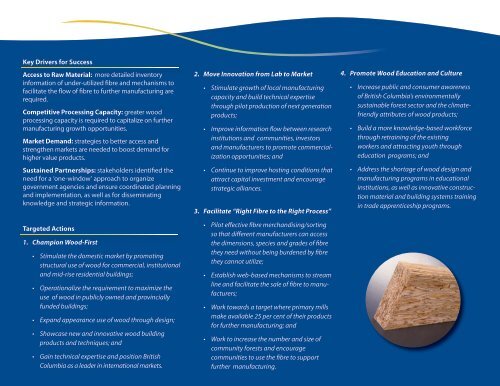Generating More Value from Our Forests - Ministry of Forests
Generating More Value from Our Forests - Ministry of Forests
Generating More Value from Our Forests - Ministry of Forests
You also want an ePaper? Increase the reach of your titles
YUMPU automatically turns print PDFs into web optimized ePapers that Google loves.
Key Drivers for Success<br />
Access to Raw Material: more detailed inventory<br />
information <strong>of</strong> under-utilized fibre and mechanisms to<br />
facilitate the flow <strong>of</strong> fibre to further manufacturing are<br />
required.<br />
Competitive Processing Capacity: greater wood<br />
processing capacity is required to capitalize on further<br />
manufacturing growth opportunities.<br />
Market Demand: strategies to better access and<br />
strengthen markets are needed to boost demand for<br />
higher value products.<br />
Sustained Partnerships: stakeholders identified the<br />
need for a ‘one-window’ approach to organize<br />
government agencies and ensure coordinated planning<br />
and implementation, as well as for disseminating<br />
knowledge and strategic information.<br />
Targeted Actions<br />
1. Champion Wood-First<br />
• Stimulate the domestic market by promoting<br />
structural use <strong>of</strong> wood for commercial, institutional<br />
and mid-rise residential buildings;<br />
• Operationalize the requirement to maximize the<br />
use <strong>of</strong> wood in publicly owned and provincially<br />
funded buildings;<br />
• Expand appearance use <strong>of</strong> wood through design;<br />
• Showcase new and innovative wood building<br />
products and techniques; and<br />
• Gain technical expertise and position British<br />
Columbia as a leader in international markets.<br />
2. Move Innovation <strong>from</strong> Lab to Market<br />
• Stimulate growth <strong>of</strong> local manufacturing<br />
capacity and build technical expertise<br />
through pilot production <strong>of</strong> next generation<br />
products;<br />
• Improve information flow between research<br />
institutions and communities, investors<br />
and manufacturers to promote commercialization<br />
opportunities; and<br />
• Continue to improve hosting conditions that<br />
attract capital investment and encourage<br />
strategic alliances.<br />
3. Facilitate “Right Fibre to the Right Process”<br />
• Pilot effective fibre merchandising/sorting<br />
so that different manufacturers can access<br />
the dimensions, species and grades <strong>of</strong> fibre<br />
they need without being burdened by fibre<br />
they cannot utilize;<br />
• Establish web-based mechanisms to stream<br />
line and facilitate the sale <strong>of</strong> fibre to manufacturers;<br />
• Work towards a target where primary mills<br />
make available 25 per cent <strong>of</strong> their products<br />
for further manufacturing; and<br />
• Work to increase the number and size <strong>of</strong><br />
community forests and encourage<br />
communities to use the fibre to support<br />
further manufacturing.<br />
4. Promote Wood Education and Culture<br />
• Increase public and consumer awareness<br />
<strong>of</strong> British Columbia’s environmentally<br />
sustainable forest sector and the climatefriendly<br />
attributes <strong>of</strong> wood products;<br />
• Build a more knowledge-based workforce<br />
through retraining <strong>of</strong> the existing<br />
workers and attracting youth through<br />
education programs; and<br />
• Address the shortage <strong>of</strong> wood design and<br />
manufacturing programs in educational<br />
institutions, as well as innovative construction<br />
material and building systems training<br />
in trade apprenticeship programs.

















